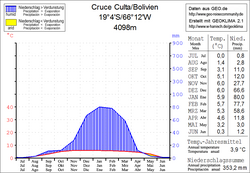Challah Mayu
| Challah Mayu | ||
|---|---|---|
| Basic data | ||
| Residents (state) | 152 pop. (2012 census) | |
| height | 3946 m | |
| Post Code | 05-0102-0106-6001 | |
| Telephone code | (+591) | |
| Coordinates | 19 ° 11 ′ S , 66 ° 5 ′ W | |
|
|
||
| politics | ||
| Department | Potosí | |
| province | Tomás Frías Province | |
| climate | ||
 Climate diagram Cruce Culta |
||
Challa Mayu is a town in the Potosí department in the highlands of the South American Andean state of Bolivia .
Location in the vicinity
Challa Mayu is a municipality in the canton of Anthura in the district ( Bolivian : Municipio ) Tinguipaya in the province of Tomás Frías . The village is located at an altitude of 3946 m on the banks of the Río Challa Mayu, which joins the Río Yarviri below the village and flows in its further course to the Río Pilcomayo , a tributary of the Río Paraguay and Río Paraná .
geography
Challa Mayu is located on the eastern edge of the Bolivian Altiplano in front of the Cordillera Azanaques , which is part of the Cordillera Central mountain range . The region's climate is typical of the time of day , in which the mean daily temperature fluctuations are more pronounced than the seasonal fluctuations.
The average annual temperature of the region is 4 ° C (see climate diagram Cruce Culta) and fluctuates between 0 ° C in June and July and 6 ° C from November to January. The annual precipitation is only 350 mm, with a pronounced dry season from April to October with monthly precipitation below 15 mm, and significant precipitation only from December to March with 60 to 80 mm monthly precipitation.
Transport network
Challa Mayu is located at a distance of 89 kilometers by road northwest of Potosí , the capital of the department of the same name.
From Potosí, the highway Ruta 1 leads north via Tinguipaya to Challa Mayu and on to Poopó , Oruro and El Alto , the neighboring town of La Paz , and to Desaguadero on Lake Titicaca .
In Challa Mayu a country road branches off to the northeast from Route 1, which after twenty kilometers reaches the village of Anthura , which in turn is five kilometers west of the Río Tinguipaya.
population
The population of the village has decreased by about a quarter in the past decade:
| year | Residents | source |
|---|---|---|
| 1992 | no detailed data | census |
| 2001 | 200 | census |
| 2012 | 152 | census |
Due to the historically grown population distribution, the region has a significant proportion of Quechua population, in the municipality of Tinguipaya 99.3 percent of the population speak the Quechua language.
Individual evidence
- ↑ INE - Instituto Nacional de Estadística Bolivia 1992 ( Memento of the original from April 23, 2014 in the Internet Archive ) Info: The archive link was inserted automatically and has not yet been checked. Please check the original and archive link according to the instructions and then remove this notice.
- ↑ INE - Instituto Nacional de Estadística Bolivia 2001 ( Memento of the original from March 4, 2016 in the Internet Archive ) Info: The archive link was inserted automatically and has not yet been checked. Please check the original and archive link according to the instructions and then remove this notice.
- ↑ INE - Instituto Nacional de Estadística Bolivia 2012 ( Memento of the original from July 22, 2011 in the Internet Archive ) Info: The archive link has been inserted automatically and has not yet been checked. Please check the original and archive link according to the instructions and then remove this notice.
- ↑ INE social data Potosí 2001 ( Memento of the original from December 15, 2011 in the Internet Archive ) Info: The archive link was inserted automatically and has not yet been checked. Please check the original and archive link according to the instructions and then remove this notice. (PDF file; 5.2 MB)
Web links
- Satellite map of Bolivia from 1: 2,000 GeoBolivia
- Relief map of the Cahuayo region 1: 50,000 Instituto Geográfico Militar Bolivia (PDF; 2.0 MB) ( accessed May 15, 2017 )
- Relief map of the Sucre region 1: 250,000 (PDF; 11.79 MB)
- Municipio Tinguipaya - General Maps No. 50102
- Municipio Tinguipaya - detailed map and population data (PDF; 656 kB) ( Spanish )
- Department Potosí - social data of the municipalities (PDF; 5.23 MB) ( Spanish )
